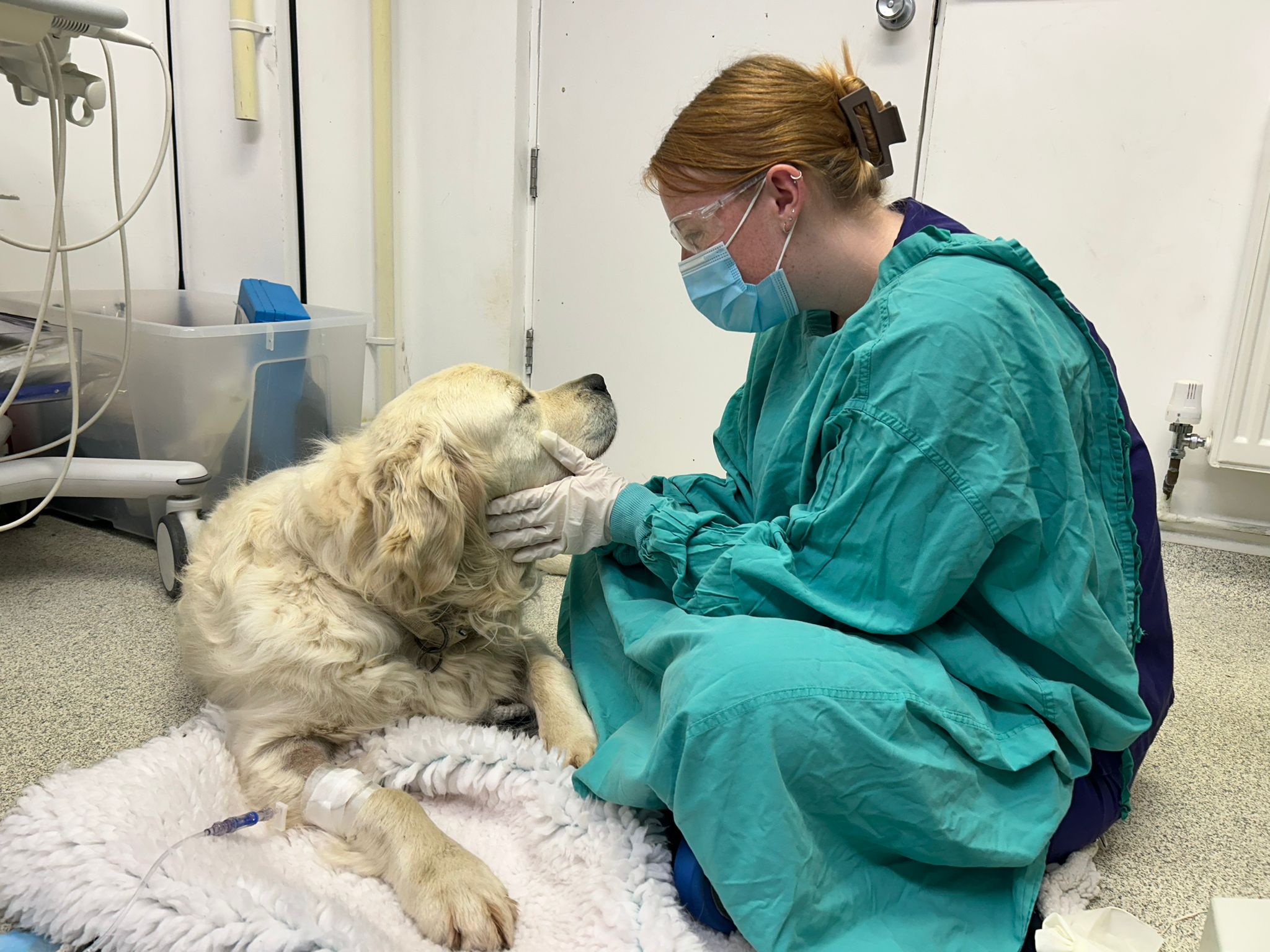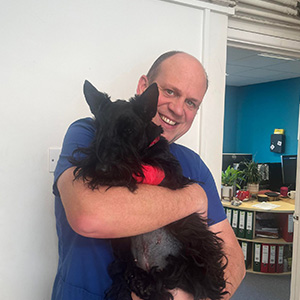Heros story: A Tale of Resilience and Hope
Hero’s Story
Published on: November, 2024
Hero the 4-year-old Golden Retriever really has lived up to his name in the last year. Whilst his story is sad in some aspects, it is ultimately a positive one, and Hero is an inspiration that we hope might help other owners with pets in the same predicament.
Hero was a happy-go-lucky dog enjoying day-to-day life with his owner and his canine companion Wynter. Earlier this year however, we saw Hero with a hindlimb lameness that had been going on for a few days. His leg was generally a little sore and he was prescribed rest and anti-inflammatories, with the plan that we would progress to perform x-rays and investigate further if he didn’t improve. With this plan in mind his owner watched him carefully over the next week, and when she felt his lameness hadn’t resolved she arranged his follow up appointment for re-examination and x-rays.
This time we felt his knee was very painful indeed on palpation, so we focused his x-rays particularly in this region to try to narrow down the potential causes for his problem. And in fact, his x-ray findings were indeed a concern. The top of his shin bone was enlarged with a very discrete area of thickened and irregular bone. These findings could potentially be caused by a few conditions, but the most likely, and most concerning, was a tumour of the bone.
Bone tumours can be very aggressive in dogs, with a short and guarded prognosis, and so finding this possibility can be very difficult news to deliver to loving owners. There are options for treatments, but these can be radical, and there is a lot of information that can be difficult to process. Hero’s owner was understandably no different and was initially in shock, but she was a hero in her own right, talking through the diagnosis and options available so she could understand the situation and plan the next steps.
We discussed taking a biopsy from the suspect area of bone, to try to confirm the diagnosis, and also performing chest x-rays and an abdominal ultrasound to look for potential tumour spread elsewhere in the body. His owner was keen to go ahead with these tests and, once they were done, there was good and bad news. The good news was that there was no evidence of tumour spread. The bad news was that the bone biopsy results were inconclusive.
Inconclusive results can happen for a number of reasons and can be frustrating. In Hero’s case this was certainly a cause of upset and distress for both us and his owner – it meant we hadn’t confirmed that Hero had a tumour, but that we definitely couldn’t rule it out either. We were still really concerned about the appearance of the lesion on x-ray – even though bone tumours are much more likely to affect older dogs than young dogs like Hero, we were worried that this is what we were dealing with. We had some difficult discussions with Hero’s owner and advised that, if he did have a tumour the ultimate treatment would unfortunately involve amputation of the affected leg. Of course, this is a distressing prospect for any owner to consider and Hero’s owner needed some time to come to terms with the situation we all found ourselves in.
There were options to consider. On the one hand we could attempt to repeat the biopsy, which may have given us a definitive answer but risked achieving a non-diagnostic result again. On the other, we could proceed straight to the amputation which would remove the lesion once and for all and allow us to test it for a definitive diagnosis, but with the risk that this major and life-changing procedure could end up being unnecessary. The latter option may sound a huge gamble, but given how likely the diagnosis was we felt this was a very legitimate option.
Hero’s owner was of course worried about the prospect of performing such a radical procedure unnecessarily but was also understandably concerned as to how Hero might cope without his leg. We could only help support her in making this decision by answering all her questions and to direct her to support groups of owners who had first-hand experience of the same dilemma.
Hero’s owner knew that, if this was an aggressive tumour, the prognosis was poor and he might only have a few weeks or months at most, but that with amputation and chemotherapy patients could have, on average, another year of healthy life after treatment. After a lot of soul searching, and researching credible sources of information, his owner decided this was the right thing for Hero.
Once the decision was made, we progressed quickly. The now very lame and painful Hero was admitted for surgery. Under a general anaesthetic combined with an epidural, he had his hindlimb surgically amputated in its entirety. After recovering from his long op and with his epidural worn off Hero was very quickly back on his (now three) feet and the relief was immediately appreciable. Through all of the agonising and decision-making it had been easy to forget quite how sore he was and although he now had only three legs his pain had completely gone. Happy Hero was back, he ate his dinner and, even better, he skipped out to find his mum!
The entire leg was sent for testing, and the results confirmed our suspicions – this was indeed an aggressive bone tumour. This was still sad news, but the tumour being removed was a good thing and we now had a further plan to help increase his life expectancy – chemotherapy.
Our aim with chemotherapy in pets is to extend quality life without making them poorly. Unlike in humans, our patients don’t understand the benefits of their treatment so we cannot justify using protocols that would cause them to suffer. So, we may not achieve the same success and cure rates as the fantastic work done in human oncology, but we can still have a positive impact on longevity and happy life. With this in mind we offered Hero’s owner with the option of him having monthly intravenous infusions of a medication that is shown to increase patients’ life expectancy. Side effects were still possible, but these were likely to be mild and manageable and so Hero’s owner was keen to give it a try.
Hero has now undertaken his 4-month period of chemotherapy and has coped brilliantly. Not only was he relaxed for his visits, but side effects were minimal, and Hero continued daily life in good spirits, despite losing a limb.
Hero is a great example of how well patients can cope in these situations. While we and his owners were rightly worried about him, in a situation where successful treatment options were limited, Hero just seemed relieved to be rid of his painful leg and play again with his friends. Indeed, when I last checked in with his owner, they were due away on a walking holiday, which she said the dogs were bound to enjoy more than the humans!




Author –
Martin Law
Discover the inspiring story of Hero, a Golden Retriever who faced a challenging health battle. Learn about the challenges, decisions, and unwavering hope that led to a positive outcome. This heartwarming tale highlights the importance of veterinary care, owner support, and a pet’s incredible resilience.
More Articles from Martin
Related Articles
Caring for your pet as we do our own

At Shepton and Wells Vets, we understand what your pets mean to you, and so our Pets team aim to care for each and every one of them as we would do our own.
We care about your pet
Our primary focus is keeping them fit, happy and healthy with comprehensive and effective preventative healthcare, advice and treatment.
We care about you
We aim to communicate clearly and honestly with you, and discuss different treatment options so that you can make the right informed choices for you and your pet.
We care about clinical excellence
We take pride in providing a high level of medical and surgical care, working together as a team to do the very best we can for your pet.











